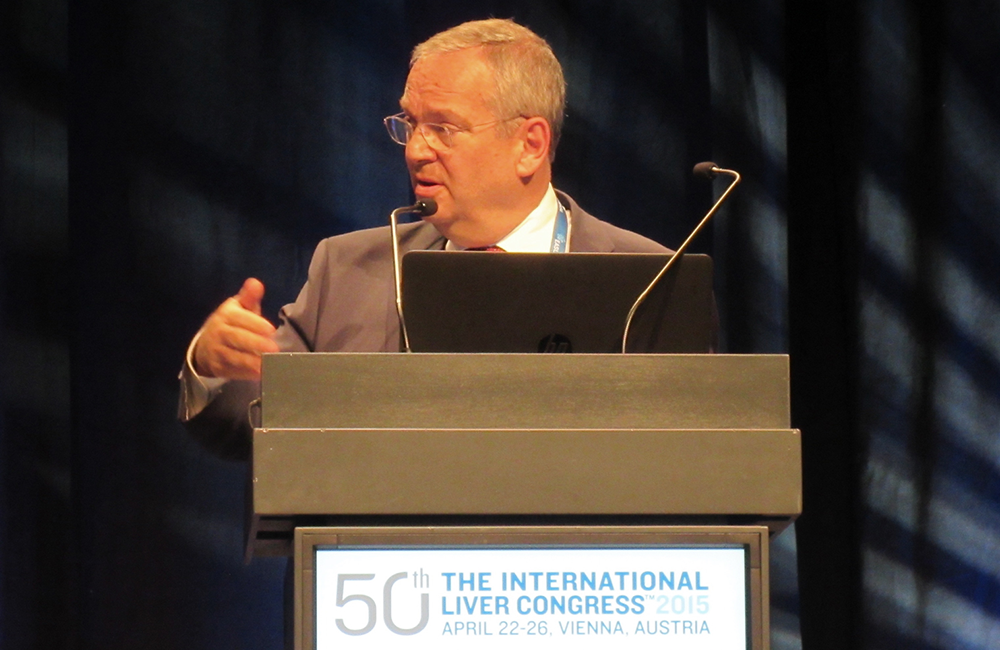
A 12-week course of treatment with two direct-acting antivirals in development by Merck cured hepatitis C infection in 90% of people with very advanced cirrhosis and at imminent risk of liver failure, Dr Ira Jacobson of Weill Cornell Medical College, New York, reported at the International Liver Congress in Vienna, Austria, on Thursday.
The preliminary phase 2 study looked at the use of a combination of the hepatitis C virus (HCV) protease inhibitor grazoprevir and the NS5A inhibitor elbasvir in people with Child-Pugh B cirrhosis.
People with a Child-Pugh B score have significantly impaired liver function and are at high risk for progression to decompensated cirrhosis. They also have a poor prognosis: on average, only 60% of people with Child-Pugh B cirrhosis survive for more than two years once they reach this stage of liver damage.
Effective treatment for people at this stage of liver disease is especially urgent, but until the introduction of interferon-free combinations treatment responses were very poor in this group of patients.
The C-SALT study was designed to evaluate the safety and efficacy of the once-daily single-tablet regimen of grazoprevir and elbasvir without ribavirin in people with genotypes 1, 4 or 6 hepatitis C infection. The study population was restricted to people with Child-Pugh B cirrhosis.
The study was divided into two phases: a phase 2 study in which the pharmacokinetics of grazoprevir and elbasvir were assessed in people with cirrhosis in comparison to a control group of people with hepatitis C who did not have cirrhosis, alongside safety and efficacy assessments, and a phase 3 study in which a larger number of people with cirrhosis will be treated.
Results of the phase II study were presented at the International Liver Congress.
Participants received grazoprevir and elbasvir for 12 weeks, without ribavirin. Grazoprevir was dosed at 50mg for people with cirrhosis rather than the usual dose of 100mg, owing to the potential for higher drug levels in people with seriously impaired liver function. Elbasvir was dosed at 50mg once daily as normal, but the drugs were administered separately rather than in a single fixed-dose pill.
The study enrolled 30 participants with Child-Pugh B cirrhosis and a control group of 10 people without cirrhosis. All participants had genotype 1 HCV infection (90% of people with cirrhosis had genotype 1a, compared to 60% of people who did not have cirrhosis). Fifty-seven per cent of those with cirrhosis were male, and all were white.
Patients had Child-Pugh B cirrhosis, and the median MELD score was 9.5 (standard deviation 2-46), indicating a moderate-to-high mortality risk in the study population.
The 12-week post-treatment (SVR12) results showed that the interferon- and ribavirin-free regimen was highly effective in this small pilot study. Ninety-five per cent of people with Child-Pugh B cirrhosis and 100% of people without cirrhosis in the control group achieved SVR12. Two post-treatment viral relapses occurred, by weeks 4 and 8 respectively, and one person died due to liver failure after achieving end-of-treatment viral suppression.
Analysis of outcomes according to Child-Pugh score showed that a Child Pugh B score of 7 or less was associated with an SVR12 rate of 95%, whereas a score of 9 or above was associated with an SVR12 rate of 50%.
Adverse events were no more frequent in the cirrhosis arm of the study, with the exception of a higher frequency of grade 3 or 4 bilirubin elevations (13.3% vs 0%), which resolved after the completion of treatment.
Jacobson I et al.Efficacy and safety of grazoprevir and elbasvir in hepatitis C genotype 1-infected patients with Child–Pugh Class b cirrhosis (C-SALT part A). J Hepatology 62 (50th International Liver Congress), S193, abstract O008, 2015.
